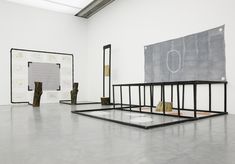Ree Morton
Ree Morton was born in 1936 in Ossining, New York, USA. In 1968, she earned a Bachelor of Fine Arts (BFA) degree from the University of Rhode Island, Kingston. In 1970, she graduated from the Tyler School of Art in Philadelphia with a Master of Fine Arts (MFA) degree. From 1970 to 1975, she taught as an assistant professor at the Philadelphia College of Art. Further teaching assignments took her to Montana State University in Bozeman in 1974, the University of California (UCLA) in San Diego from 1975 to 1976, and the Art Institute of Chicago in 1977. Ree Morton Morton died in 1977 as the result of a car accident in Chicago
Ree Morton was an American artist from the generation of Eva Hesse and Paul Thek. She similarly challenged the conceptual art and minimalist orthodoxy of the 1970s by combining elements of historical art, ritual, and decor with the analytical rigor of a structural mapping of space. Underlying her thinking was a rich reservoir of sources of literary, philosophical, and ethnological provenance. In 2008-2009, the Generali Foundation dedicated the first comprehensive retrospective in thirty years to the artist, presenting the first institutional show of her work in Europe.
Influenced by structuralist thinkers and writers or their forerunners such as Martin Heidegger, Maurice Merleau-Ponty, Ludwig Wittgenstein, Claude Levi-Strauss, Rudolf Arnheim and Raymond Roussel or Walter Abish and architects such as Christian Norberg-Schulz or Louis Sullivan, Morton was particularly interested in the phenomenology of real and imagined topographies as well as - a thoroughly contemporary moment - in ritual sign systems of indigenous cultures. Thus, her early works are cartographic transfers of literary texts and biographically colored mental maps into spatial experimental arrangements that rely on natural and found materials, such as tree trunks or branches, combined with sign-like markings. As a contemporary witness of urbanist modernism, she reflected, like many others-Gordon Matta-Clark, Robert Smithson, and many land-art artists-a particular interest in dealing with the relationship between nature and culture, between an archaeology of the industrial age and recourse to so-called primitive modes of construction, namely the "primitive hut."
Morton emphasized the value of intellectual action, of thinking that only becomes effective in real everyday action. She spoke with the philosopher Miguel de Unamuno of the "method of vitalizing thought." Morton's notes represent a form of instructions for action to herself, with which she forced herself to be more precise in a process of confrontation with artists and currents of thought.
Beginning in 1974, her mode of expression became more expressive: as a border crosser of form, she did not shy away from ornamentation, extreme coloration, and unusual materials. Later, she added a rich vocabulary of heraldic and other pictorial borrowings. Her installations became veritable baroque stage spaces. At the same time, Jerzy Grotowski, the Polish theater director and theorist of "poor theater" who was in America at the time, inspired and influenced Morton toward a minimalization of effects in the theatrical and performative.
In 1977, after a period of proliferating forms and colors, she called herself to order and seriousness: "It seems to me that things have to be more serious ..." Her work Manipulations of the Organic, a tribute to Louis Sullivan, was her last work.
Morton was a late-comer. She explains the reason in a notebook entry, "I guess my career began when I was three years old and started watching anthills and rescuing ladybugs. The result was a long pause in my artistic development, as my family interpreted it as a scientific interest and encouraged me to train as a nurse." To the study of art, Morton turned only in 1965, after marrying a naval officer and giving birth to three children. (Sabine Folie)
